Moon rotates once for every one revolution around the Earth. We see
only one side of the Moon.
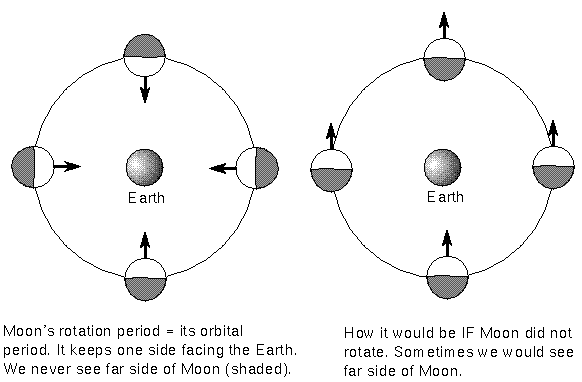
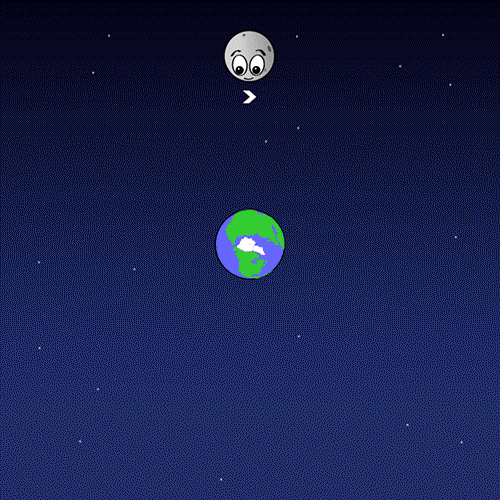
Animation does not show that Earth spins much faster than Moon moves--over 27 times for every one Moon orbit
Link to mpeg of spinning Moon from Clementine spacecraft.
Starts out with near side. Slide the slider to view far side of the Moon.
Phases of the Moon
Synodic Period
-
The time it takes for an object to get back into the same relative position with
respect to the Sun (time between successive occurrences of a planetary or lunar configuration).
Moon's phases repeat after 29.53 days---its synodic
period.
Phases are caused by the angle between the Sun and Moon on your sky that will
determine how much of the illuminated side of the Moon you can see.
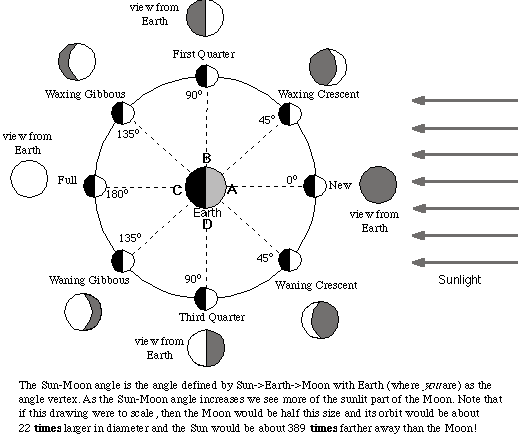

New phase is right with the Sun
1st quarter phase is 1/4-Earth turn = 6 hours behind Sun
full phase phase is 1/2-Earth turn = 12 hours behind Sun
3rd quarter phase is how much an Earth turn? = ? hours behind Sun = 6 hours AHEAD of Sun
How it would be IF Earth's shadow caused the phases:
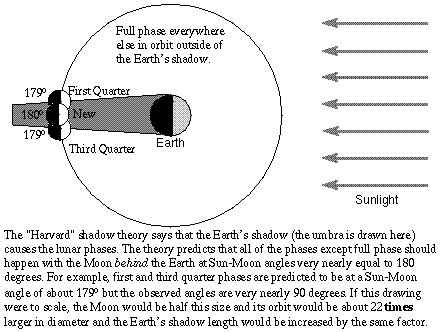
The diagram shows how the angles between the Sun and Moon
would be very different from what is actually observed. New phase Moon is predicted to
be 180 degrees from the Sun, but the observation (reality!) is that
the New Moon is very close to the Sun (less than 6 degrees from the Sun).
Also, the bogus shadow model predicts all the phases
except the full phase are 12 hours behind the Sun. The observation (reality!)
is very different: new phase is right with Sun, first quarter is 6 hours
behind the Sun, etc.
Shadow model predicts angles + timing of the phases. Observation
(REALITY) contradicts the shadow model. Therefore, shadow model is WRONG
(not observation, i.e., observation/facts are always right!). Scientific models must match reality!
Do the "Lunar Phases Worksheet" in the Student
Guide.
In the waxing moon animations below, notice how the moon trails behind the sun across the sky during the day. (If the moon was in the waning phase position of its orbit, it would be ahead of the sun.) Also notice that when the observer is facing the sun, it is noon AND the sun is on the meridian. Also notice that when the observer is facing the moon, the moon is on the meridian. South moves with the observer! Also notice that Earth spins counter-clockwise which makes the sun rise in the east and set in the west. Finally, the observer is raising her RIGHT hand, so you are looking at the back of her head (not her face).
| Waxing crescent animation |
Waxing gibbous animation |

The waxing crescent phase rises after sunrise and trails behind the Sun by a few hours (here 3 hours) throughout the day. |
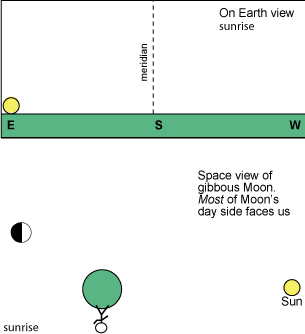
The waxing gibbous phases rises after sunrise and trails behind the Sun by several hours (here 9 hours) throughout the day. |
Also do the "Mapping the Solar System from Earth" in the
Student Guide. This will help you predict what time of day you will see a
given phase of the Moon and where it will be in the sky. (If you learn the technique, you can use it for ANY object, not just the Moon.)
Example for Moon Phase: When does this phase get up highest in the sky?

Steps
1. Identify phase: GIBBOUS and Waxing/Waning sheet in lecture outlines of Student Guide shows this has to be WANING GIBBOUS (“d”-wane)
2. Place in orbit. (Have Sun on LEFT since daylit side of Moon faces LEFT)
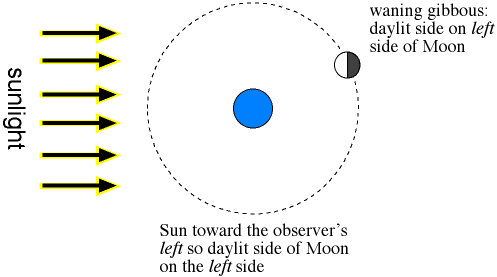
3. Position observer on Earth. Here: Moon highest when on meridian => observer pointed towards Moon
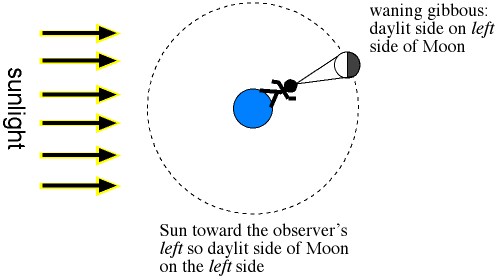
4. Determine TIME for observer position. Here: between midnight and sunrise (looks close to 2 AM in picture)
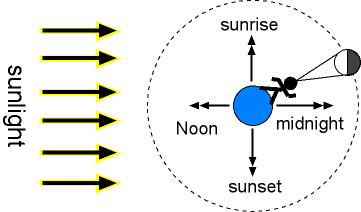
=========================
Another example: given the geocentric (Earth) view at 4 PM, place objects in orbit positions.
The meridian arc goes through the due South and “overhead x” (zenith) positions in the figure below. Mars is on the meridian arc because it is due South.
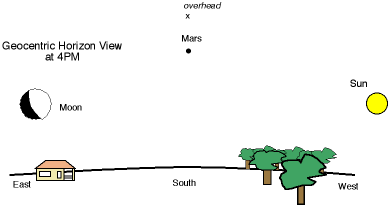
Step 1: Draw Earth and Sun position and then determine noon direction, sunset direction, midnight direction, sunrise direction. Noon always toward Sun and Earth spins counter-clockwise. In this example, we'll choose the Sun to be toward right side of the picture just for fun. Place observer at 4 PM position.
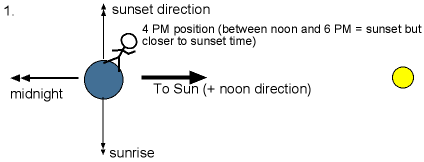
Step 2: Draw the observer's horizon, then draw south direction (that's the direction his part of the Earth is facing). In the figure, we're looking at the back of his head, so we're facing the same direction as he is. The observer is racing his RIGHT hand, then. Note that south, east, and west constantly shift in direction in 3D space because of the Earth's spin. South, east, and west spin with the observer. Here's the 4 PM position:

Step 3: In the Earth ground (geocentric) view at the start of this exercise, the Moon is partway up in the eastern sky on the observer's left side, so place the Moon partway above the eastern horizon line. Mars is due South, so put Mars in direction of the south arrow:
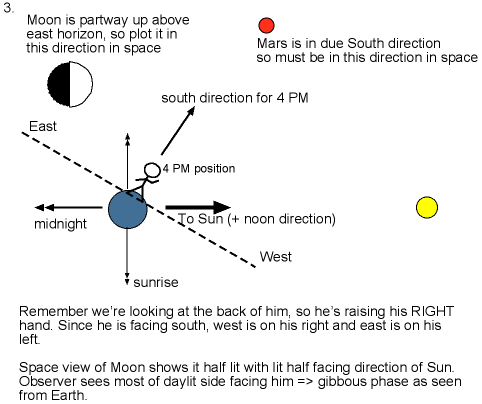
Step 4: Now shrink Moon, Earth, and Mars down but keep in same relative positions as you place them on the orbit (orrery) view. The Sun will be toward the right side of the picture relative to the Earth, so put the Earth on the left side of its orbit path:
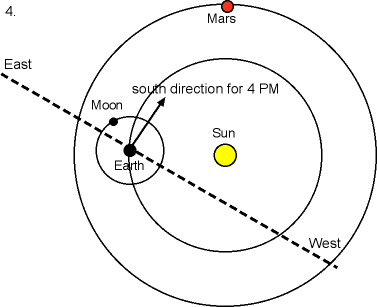
Show geocentric (Earth) view again:

Lecture slides (select the links to view the slides)















